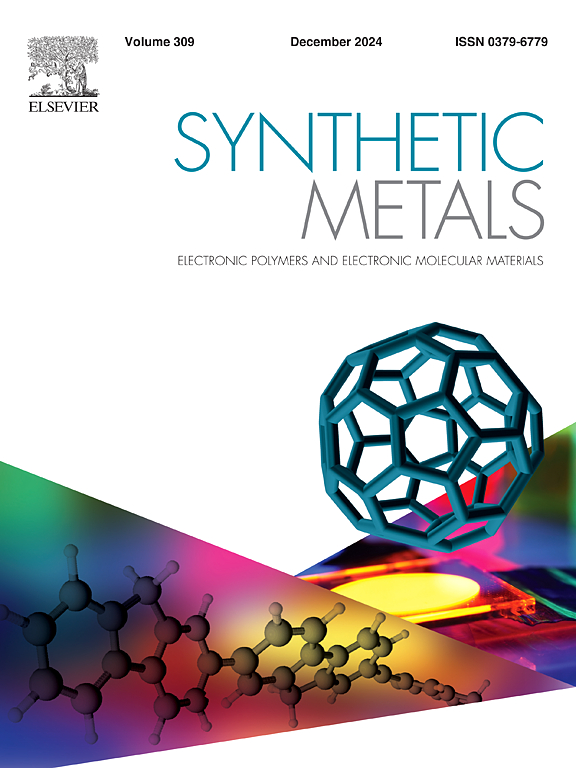Novel tetrapod-structured cerium-MOF/GO edifices in a redox-additive electrolyte for high-performance smart supercapacitors
IF 4.6
3区 材料科学
Q2 MATERIALS SCIENCE, MULTIDISCIPLINARY
引用次数: 0
Abstract
The increasing demand for efficient energy storage systems has driven research into high-performance advanced materials for supercapacitors. Current advancement in the creation of smart supercapacitors leads to the introduction of Cerium-(Metal-Organic-Frameworks)/Graphene Oxide (Ce-MOF/GO) edifices as active electrode materials, investigating two distinct morphologies of the MOF precursor. Structural transformations were analyzed using X-ray diffraction (XRD) with Rietveld refinement, which confirmed the formation of Ce-MOF/GO. High-resolution transmission electron microscopy (HR-TEM) revealed uniformly dispersed tetrapod-structured Ce-2,6-Naphthalenedicarboxylic acid/GO (CDG) and rod-structured Ce-1,3,5-Benzenetricarboxylic acid/GO (CTG) crystallites within the GO matrix, whereas Fourier transform infrared (FT-IR) spectroscopy revealed the oxygen-comprising functional groups attached to their surface. The electrochemical performance was evaluated through cyclic voltammetry (CV), galvanostatic charge-discharge (GCD), and electrochemical impedance spectroscopy (EIS) in a redox-additive electrolyte, for which CDG demonstrated noteworthy performance based on various parameters, owing to its tetrapod structure which furnishes greater surface area and more active sites, leveraging ion diffusion and redox reactions. CDG demonstrated an outstanding specific capacitance of 2372.08 F g−1 at a current density of 1 A g−1, and a high energy density of 766.84 Wh kg−1 at a power density of 4.00 kW kg−1, in the redox-additive [KOH + KFC] electrolyte, whilst retaining 94.83 % of the initial capacitance after 10,000 charging/discharging cycles. These findings underscore the potential of Ce-MOF/GO composites, particularly CDG, making it a promising candidate for next-generation smart supercapacitors, with applications ranging from sustainable energy solutions to adaptive, intelligent devices in modern electronics.
高性能智能超级电容器氧化还原添加剂电解质中新型四足结构铈- mof /GO结构
对高效储能系统日益增长的需求推动了对超级电容器高性能先进材料的研究。当前在智能超级电容器制造方面的进展导致引入了铈(金属有机框架)/氧化石墨烯(Ce-MOF/GO)结构作为活性电极材料,研究了MOF前驱体的两种不同形态。利用Rietveld细化的x射线衍射(XRD)分析了结构转变,证实了Ce-MOF/GO的形成。高分辨率透射电子显微镜(HR-TEM)观察到氧化石墨烯基体内均匀分散的四足结构ce -2,6-萘二羧酸/氧化石墨烯(CDG)和棒结构ce -1,3,5-苯三羧酸/氧化石墨烯(CTG)晶体,傅里叶变换红外光谱(FT-IR)发现其表面附着含氧官能团。通过循环伏安法(CV)、恒流充放电法(GCD)和电化学阻抗谱法(EIS)对氧化还原添加剂电解质的电化学性能进行了评价,其中CDG由于其四足结构提供了更大的表面积和更多的活性位点,利用离子扩散和氧化还原反应,在各种参数下都表现出了显著的性能。在氧化还原添加剂[KOH + KFC]电解质中,CDG在电流密度为1 a g−1时的比电容为2372.08 F g−1,在功率密度为4.00 kW kg−1时的高能量密度为766.84 Wh kg−1,在10,000次充放电循环后仍保持94.83 %的初始电容。这些发现强调了Ce-MOF/GO复合材料的潜力,特别是CDG,使其成为下一代智能超级电容器的有希望的候选者,其应用范围从可持续能源解决方案到现代电子产品中的自适应智能设备。
本文章由计算机程序翻译,如有差异,请以英文原文为准。
求助全文
约1分钟内获得全文
求助全文
来源期刊

Synthetic Metals
工程技术-材料科学:综合
CiteScore
8.30
自引率
4.50%
发文量
189
审稿时长
33 days
期刊介绍:
This journal is an international medium for the rapid publication of original research papers, short communications and subject reviews dealing with research on and applications of electronic polymers and electronic molecular materials including novel carbon architectures. These functional materials have the properties of metals, semiconductors or magnets and are distinguishable from elemental and alloy/binary metals, semiconductors and magnets.
 求助内容:
求助内容: 应助结果提醒方式:
应助结果提醒方式:


